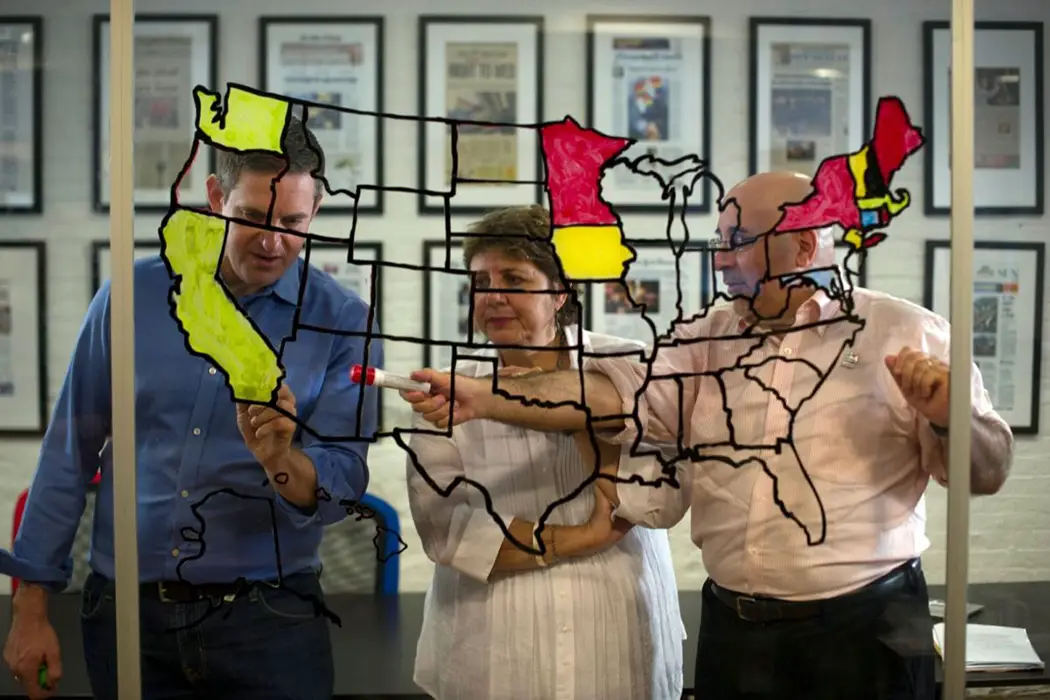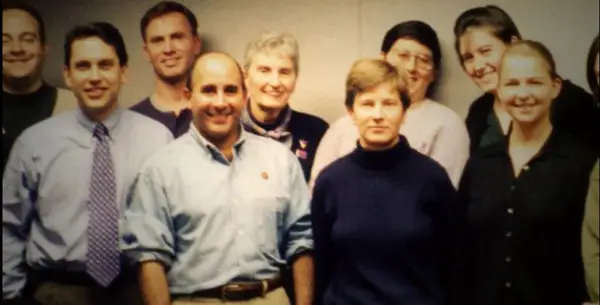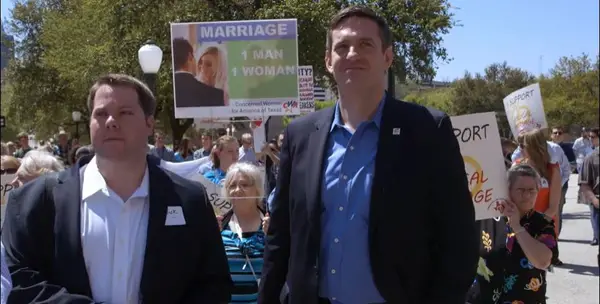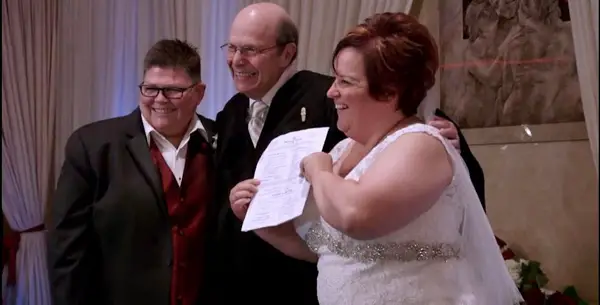THE FREEDOM TO MARRY: Love Conquers Fear

Brian Walter is a college professor by day and a…
Perfect love casteth out fear.
At one point in the latter stages of the deeply moving documentary The Freedom to Marry, director Eddie Rosenstein and editor Pilar Rico effectively dramatize this old but vital bit of Biblical wisdom. Cutting from a group of hopeful, joyful marriage equality advocates creatively preaching Christian love in church to a restless and rather belligerent group of curiously self-styled marriage ‘defenders’ brandishing bullhorns and angry signs on the steps of the nation’s capitol, the filmmakers help to show that yes, indeed, fear remains the desperate enemy that love must, still and always, find a way to calm and finally vanquish within its embrace.
But if that is the single sequence that most deftly crystallizes the old Biblical insight, the film as a whole works superbly to drive home love’s innate incompatibility with fear. Following several key figures in the decades-long movement to win the legal right to marry for same-sex couples, The Freedom to Marry builds powerfully toward the landmark decision that finally recognized this right in the summer of 2015. In the process, this documentary confirms the power of the medium both to champion and to celebrate long-delayed social justice.
Completed mostly before the results of the 2016 presidential election, The Freedom to Marry nevertheless offers a powerful antidote to the vast, even enveloping forces of fear that have continued to shake our culture in the election’s aftermath. Beautifully tuned both to combat and to ease those fears, this is a film for marriage equality advocates to share and watch together with their loved ones who continue, actively or passively, to feed on the needless fears that would still oppose the legal recognition of all marital unions.
Marriage Equalizers
Much of the film focuses on three dedicated attorneys determined to see marriage equality into legal being. Blending their personal stories with their professional efforts, the film puts a warmly human face on a cause that has too often and easily been caricatured and distorted.
Evan Wolfson’s story takes the film down the oldest, longest, and intermittently darkest memory lane, back to Stonewall, the early days of the AIDS crisis, and the efforts of many in ’70s- and ’80s-era America to pretend homosexuality out of existence (or at least out of sight). Long before he wrote his Harvard Law School thesis in the early ’80s on the topic of marriage equality, Wolfson was a keen tracker of trends and developments in U. S. society, already avidly reading the New York Times as a preschooler.
When he returned from the Peace Corps years later and announced that he was gay, his family reluctantly (and tellingly) let go of its prediction that he would become our first Jewish president. But they remained confident (as they attest in the film) that he would go on to achieve something of historical moment.
The fight for legal marriage equality has largely been Wolfson’s fight. Short and rather round now in middle age, looking a bit like a pleasant, bespectacled hobbit bereft of his brown, curly wig, Wolfson hardly resembles our cultural stereotype of a crusader hero, but his story, as revealed in the film, resoundingly shows otherwise.
In one early sequence as painfully vulnerable as it is otherwise compelling, we see the 20-something Wolfson, not long out of law school in Reagan‘s America, rendered speechless in a VHS-taped interview conducted by his brother, as he tries to explain the deep injustice of the law’s categorical consignment of same-sex relationships to a lesser status. The sequence is brief but the effect profoundly touching, as we see fierce, principled advocacy struggling to find its way up from the deeply loving heart and out through the superbly educated head.

If Wolfson is the ‘godfather’ of the marriage equality movement, then Mary Bonauto is (as one interviewee in the film puts it) the movement’s ‘godmother,’ the first attorney hired as a civil rights project lawyer in the cause. Bonauto is also the attorney who argued the case of Michigan lesbian couple April Deboer and Jane Rowse before the Supreme Court in the landmark 2015 decision that lends the film much of its narrative drive. As the viewer quickly and gratefully recognizes, the startlingly blue-eyed Bonauto (who has enjoyed an open relationship with her own partner in Massachusetts for many years) quite literally carries the hopes of millions of gay people into the Supreme Court crucible — an unimaginably heavy but also an inspiring burden.
The third member of the film’s formidably lovable legal troika is Marc Solomon, a tall, clean-cut, athletic looking Mutt to Wolfson‘s delightfully hobbity Jeff. Born to two ‘activist, liberal Democrats’ in suburban Kansas City, Solomon was so desperate to pretend to the world that he was straight that he donned the guise of a young Republican macho to campaign for Reagan and Bush the elder in the 1980s. When he finally came out some years later to his parents, his stupefied father (with whom the younger Solomon religiously watches Kansas City Royals baseball games to this day) registered his disbelief by pointing out that his jock son could still throw a football 60 yards – ‘whatever in the hell that means,’ as he wryly adds in afterthought now.

The film cleverly arrays this trio of disarmingly personable counselors against the stubbornly and elaborately rationalized fears of the marriage ‘defenders’ featured in the film. One of the talking heads most prominently featured for the con side is Brian Brown, President of the National Organization for Marriage, who tries to explain that the ‘church’ (it’s not clear which one he’s referring to; he later collapses the reference into ‘traditional Christianity’) calls on us to draw a sharp line between our sexual orientation (or ‘choices,’ as he also refers to it) and our actions. He adds that ‘it’s not supposed to be easy’ — and then tops himself rather helplessly with the frank (and tellingly absurd) declaration, ‘In fact, it’s not even necessarily supposed to feel as if it’s humanly possible.’
The inclusion of Brown and other self-styled Christian opponents of marriage equality in commensurately lit and framed interviews is an important and conscientious strategy, of course. And it’s not just that their unmistakable struggles to clothe bigotry and needless fear in selectively and dubiously Christian dogma so tilts the playing field in favor of the advocates.
It’s also the simple realization that a Brian Brown grew up with and has shared classroom lessons and theater dates and mall outings and locker room changings with the Wolfsons and Bonautos and Solomons his whole life, all in blissful ignorance of the difference that has so enflamed Brown’s resistance now. Sharing screen time with those whom he insists on treating as his opponents and moral inferiors, Brown faces viewers with an increasingly ponderous question: what exactly is the problem here? Why would straight people even care if the law finally comes to recognize same-sex unions?
Master-Class in Editing
But such polemical questions rise and slip away from consciousness quickly and naturally in the midst of the impressive momentum that the film builds toward the Supreme Court’s 2015 decision. If Hitchc*ck definitively demonstrated that a combination of careful visuals, auditory effects, and Eisenstein-inspired editing techniques could cause middle-class American moviegoers to find themselves somehow rooting gleefully for the killer to finally succeed in committing murder, then The Freedom to Marry shows how similar techniques in a social cause documentary can win similarly middle-class viewers over to moral causes that they might well have resisted at the start.

From the opening montage sequence featuring Wolfson leaving his apartment 102 days (as an intertitle helpfully orients us) before the final decision all the way through to the end credits celebrating a legal same-sex wedding in heartland Michigan, the film consistently serves up a master class in editing. The deftly blended steadicam, static, and unsteady handheld camera perspectives of both interiors and exteriors combine seamlessly with archival and news footage to lend unobtrusive energy to the talking head sequences that inevitably consume much of the screen time. Sound bridges and other effects smooth the transitions across the film’s many settings and story-lines, incorporating keyboard and string arrangements that often remind one of Philip Glass.
One of many favorite sequences interleaves shots of the crowd and the three featured attorneys on the steps of the Supreme Court after oral arguments. Undercranked images of hopeful advocates moving rapidly in and out of the frame combine with shots of the Wolfson–Bonauto–Solomon attorney team and their clients expressing cautious optimism that the justices will finally afford same-sex couples’ children the same protections as hetero couples’ children enjoy. The visual and sound editing in this sequence superbly ties the empathy we feel for those who have lived their lives as second-class citizens to the ever-building suspense around the verdict. How do you make a hugely publicized legal verdict handed down more than a year before the film reached the screen such an emotional cliffhanger?
Major Ambitions, a Few Minor Weaknesses
As with any work of art this ambitious and capacious, some sequences and elements don’t work quite as well as others. Perhaps the most surprisingly unsuccessful sequence features Bonauto late in the film commenting on audio recordings of some of her oral argument exchanges with the justices; the sequence aims to prolong the suspense for the delayed verdict, but it unfortunately comes across unconvincingly as a kind of hindsight spin control.
At several points, the camera’s attempt to play fly-on-the-wall in meetings and more or less private conversations also feels artificial, as non-actors try unsuccessfully to pretend the camera isn’t there. It does help here that the film has already endeared the Bonautos and the Solomons to viewers; we like them too much to hold their occasional awkwardness against them – but the frequent awkwardness remains unmistakable.
And the remarkably, almost universally consistent middle-class whiteness of the key voices and players in the film might prompt some uncomfortable questions about inclusivity. Has the drive for marriage equality really been so white-sanitized as this film can sometimes feel?
Hearts and Minds
But these minor asterisks cannot obscure the superbly grace-noted poetry that this film finally achieves. While no film can hope all by itself to win hearts and minds — particularly not those that have smothered themselves in fear for so long a time — this one restores faith in the idea that the law and concerted, thoughtful, loving legal action can change lives and an entire society for the better.

Not to mention that it’s just a compelling journey of a movie experience. It’s been a long time since a film so consistently moved me to tears of both sadness and joy as did The Freedom to Marry. In this film, love’s innate and remarkable power works marvelously to overcome the helpless, potent antagonism of fear in all the many forms that it takes and the masks that it dons. It’s a gift of a movie, one worth sharing particularly with our family and friends who remain most helplessly enslaved by their needless fears, helping us embrace the love that will finally cast our fears out.
Why did U. S. law take so long to recognize the freedom to marry?
The Freedom to Marry was released in the U. S. on March 3rd.
Does content like this matter to you?
Become a Member and support film journalism. Unlock access to all of Film Inquiry`s great articles. Join a community of like-minded readers who are passionate about cinema - get access to our private members Network, give back to independent filmmakers, and more.
Brian Walter is a college professor by day and a hopelessly sleepy college professor by night. His work has appeared in a variety of literary and film studies publications, and he appears as an 'old coot' interviewer with a magic camera in the final chapter of Donald Harington's final novel, "Enduring." He lives a short walk from the St. Louis Zoo with his remarkably patient, loving wife and a quirky assortment of canine and feline familiars.













